על ידי כריס Grinter, on July 25th, 2011 This Monday I am departing from the usual Arctiinae for something completely different – a microlep! This is a Nepticulidae, Stigmella diffasciae, and it measures in at a whopping 6 מ"מ. I can’t take credit for spreading this moth – all of the nepticulids I have photographed are from the California Academy of Sciences and spread by Dave Wagner while he was here for a postdoctorate position.
The caterpillars mine the upper-side of the leaves of Ceanothus and are known only from the foothills of the Sierra Nevada in California. If you’re so inclined the revision of the North American species of the genus is freely available here (.pdf).
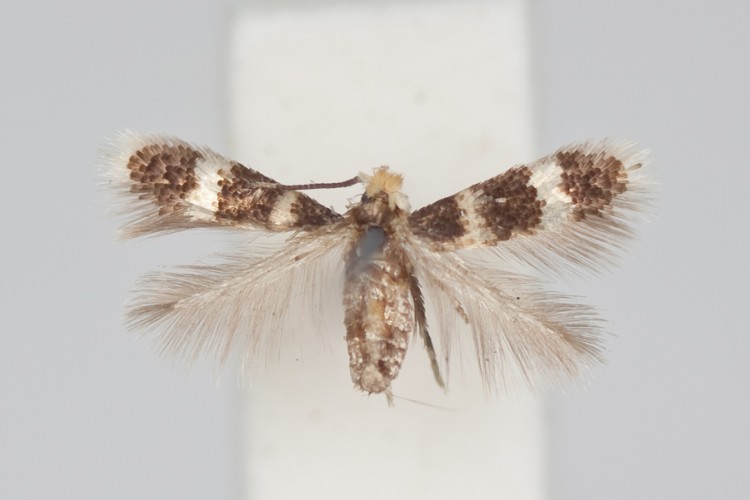 Stigmella diffasciae (Nepticulidae)
על ידי כריס Grinter, ב 22 ביולי, 2011 זה היה קצת זמן מאז אתגר הרפובליקנים האחרון, אבל this is a softball. אני מקווה שהם פשוט עצלנים מדי כדי למצוא תמונה מתאימה יותר…

על ידי כריס Grinter, ב 19 ביולי, 2011 מה היית עושה אם היה לי ישו הוא קצת זמן פנוי – אולי לרפא מחלה, בסופו של מלחמה, או להאכיל רעב – אבל לאא, כולם רואים את זה מגיע. למה לא לזעזע אותם לליבה – לשרוף את הפנים שלך על קבלת Walmart! לפחות, that’s what a couple in South Carolina believe to have found, א Walmart receipt with Jesus’s face on it. This isn’t exactly new or exciting, humans have a wonderful ability to recognize a face in just about anything. Jesus and other characters “appear” on random things all the time, and even in 2005 a shrine was built to the Virgin Mary around a water stain in a Chicago underpass.
פראידוליה anyone? למעשה, that face looks pretty convincing, I’m not too sure this wasn’t just faked or “enhanced”. The closeups even look like there are fingerprints all over it. Since I don’t have a walmart anywhere near me or a walmart receipt on hand I can’t determine how sensitive the paper is and how easy it would have been to do – but how long do you think before it shows up on ebay? בכל אירוע, it looks much more like James Randi to me than Jesus (at least we actually know what Randi looks like!).
 from CNN
על ידי כריס Grinter, ב -18 ביולי, 2011 מעל בArthropoda, בחור SFS לוגר מייקל בוק משותף תמונה של חבר תחומו, Plugg צפרדע עצים הירוקה. My first thought was of a similar tree frog that haunted welcomed me everywhere I went in Santa Rosa National Park, קוסטה ריקה. למותר לציין, Costa Rica instills a sudden habit of double checking everything you are about to do. This species is known as the milk frog (Phrynohyas venulosa) for their copious amounts of milky white toxic secretions. One of the first stories Dan Janzen told me while while I was with him at Santa Rosa was about this species – and accidentally rubbing his eye after holding it. Thankfully the blindness and burning was only temporary.
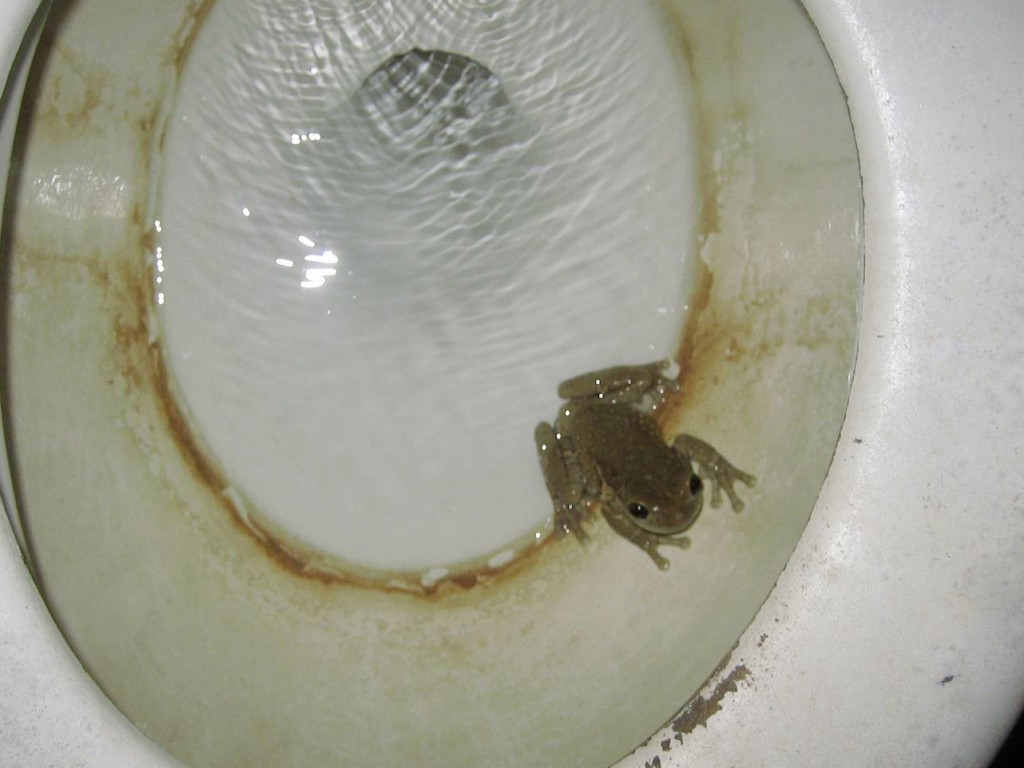 Milk Frog: Phrynohyas venulosa
על ידי כריס Grinter, ב -18 ביולי, 2011 I’ll keep the ball rolling with Arctiinae and post a photo today of Ctenucha brunnea. This moth can be common in tall grasses along beaches from San Francisco to LA – although in recent decades the numbers of this moth have been declining with habitat destruction and the invasion of beach grass (Ammophila arenaria). But anywhere there are stands of giant ryegrass (Leymus condensatus) you should find dozens of these moths flying in the heat of the day or nectaring on toyon.
 Ctenucha brunnea (ערבידי: Arctiinae)
על ידי כריס Grinter, on July 12th, 2011 Well as you may have guessed the subject isn’t as shocking as my title suggests, but I couldn’t help but to spin from the Guardian article. I really find it hilarious when I come across anything that says scientists are “astounded”, “baffled”, “shocked”, “puzzled”, – I guess that’s a topic for another time… Nevertheless a באמת cool butterfly has emerged at the “Sensational Butterflies” exhibit at the British Museum in London – gynandromorph דו צדדי! The Guardian reports today that this specimen of Papilio memnon just emerged and is beginning to draw small crowds of visitors. I know I’d love to see one of these alive again – although the zoo situation would take away quite a bit of the excitement. I think the only thing more exciting than seeing one of these live in the field would be to net one myself!
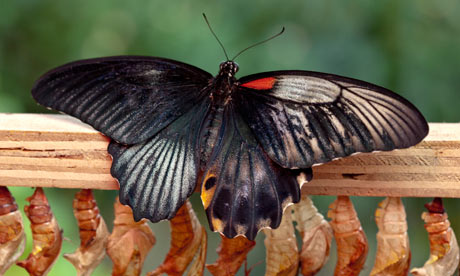
One little thing tripped my skeptical sensors and that is the quote at the end of the article taken from the curator of butterflies, Blanca Huertas. “The gynandromorph butterfly is a fascinating scientific phenomenon, and is the product of complex evolutionary processes. It is fantastic to have discovered one hatching on museum grounds, particularly as they are so rare.”
ובכן, I don’t specifically see how these are a “product of … evolutionary processes” inasmuch as all life in all forms is a product of evolution. These are sterile “glitches” that are cool, but not anything that has been specifically evolved for or against. Perhaps it would be more adept to call this a fascinating process of genetics (which the article actually describes with accuracy). כמו כן – butterflies emerge as adults and hatch as caterpillars – but that’s just me being picky.
על ידי כריס Grinter, on July 11th, 2011 Today’s moth is a beautiful and rare species from SE Arizona and Mexico: Lerina incarnata (ערבידי: Arctiinae). Like many other day flying species it is brilliantly colored and quite likely aposematic. After all, the host plant is a milkweed and the caterpillar is just as stunning (להלן).
 Lerina incarnata (ערבידי: Arctiinae)
This image of an old, spread specimen hardly does the animal justice, but one lucky photographer found a female ovipositing at the very top of a hill outside of Tucson, אריזונה. While you’re at it go check out some of Philip’s other great photographs on SmugMug.
 Lerina incarnata - Philip Kline, BugGuide As I mentioned above this moth also has an equally impressive caterpillar that feeds on Ascleapias linaria (pineneedle milkweed).
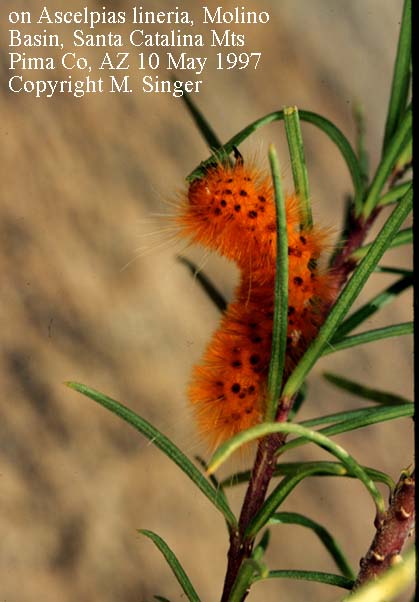
על ידי כריס Grinter, על יולי 5, 2011 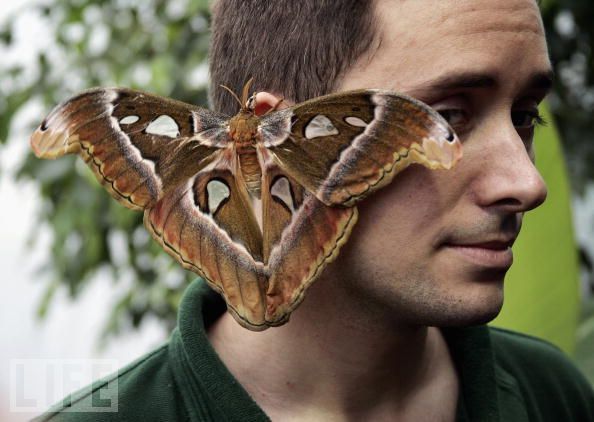
נראה שיש שכיחות של אגדות אורבניות הכוללות חרקים שזוחלים לתוך הפנים שלנו בזמן שאנחנו ישנים. המיתוס המפורסם ביותר הוא משהו בסגנון “אתה אוכל 8 עכבישים בשנה בזמן השינה“. בעצם כשאתה מחפש בגוגל שהמספר נע בין 4 עד 8… עד קילו? לא מפתיע דברים כל כך מוגזמים באינטרנט, במיוחד כשזה נוגע לארכנופוביה הפופולרית כל כך. אני בספק שהאמריקאי הממוצע אוכל יותר מכמה עכבישים במשך כל חייו; הבית שלך פשוט לא צריך לזחול עם כל כך הרבה עכבישים שהם יגמרו בפה שלך כל לילה! מיתוס דומה הוא עדיין מיתוס אבל עם גרעין של אמת – שצמידי אוזניים מתחפרים במוח שלך בלילה כדי להטיל ביצים. זה לא נכון שקווי אוזניים הם טפילים אנושיים (למרבה המזל), but they do have a predisposition to crawl into tight, damp places. It is possible that this was a frequent enough occurrence in Ye Olde England that the earwig earned this notorious name. Cockroaches have also been documented as ear-spelunkers – but any crawly insect that might be walking on us at night could conceivably end up in one of our orifices.
I have however never heard of a moth crawling into an ear until I came across this story today! I guess a confused Noctuid somehow ended up in this boy’s ear, although I can’t help but to wonder if he put it there himself… Moths aren’t usually landing on people while they are asleep nor are they that prone to find damp, tight spots. But then again anything is possible, some noctuids do crawl under bark or leaves in the daytime for safe hiding. I even came across another story of an ear-moth form the UK (not that the Daily Mail is a reputable source).
כמובן, some lazy news sources are using file photos of “moths” instead of copying the photo from the original story. It’s extra hilarious because one of the pictures used is of a new species of moth described last year by Bruce Walsh in Arizona. Lithophane leeae has been featured on my blog twice before, but never like this!
On a closing note here is a poem by Robert Cording (also where the above image was found).
Consider this: a moth flies into a man’s ear
One ordinary evening of unnoticed pleasures.
When the moth beats its wings, all the winds
Of earth gather in his ear, roar like nothing
He has ever heard. He shakes and shakes
His head, has his wife dig deep into his ear
With a Q-tip, but the roar will not cease.
It seems as if all the doors and windows
Of his house have blown away at once—
The strange play of circumstances over which
He never had control, but which he could ignore
Until the evening disappeared as if he had
Never lived it. His body no longer
Seems his own; he screams in pain to drown
Out the wind inside his ear, and curses God,
Who, hours ago, was a benign generalization
In a world going along well enough.
On the way to the hospital, his wife stops
The car, tells her husband to get out,
To sit in the grass. There are no car lights,
No streetlights, no moon. She takes
A flashlight from the glove compartment
And holds it beside his ear and, unbelievably,
The moth flies towards the light. His eyes
Are wet. He feels as if he’s suddenly a pilgrim
On the shore of an unexpected world.
When he lies back in the grass, he is a boy
שוב. His wife is shining the flashlight
Into the sky and there is only the silence
He has never heard, and the small road
Of light going somewhere he has never been.
– Robert Cording, Common Life: Poems (Fort Lee: CavanKerry Press, 2006), 29–30.
על ידי כריס Grinter, ב 30 ביוני, 2011 
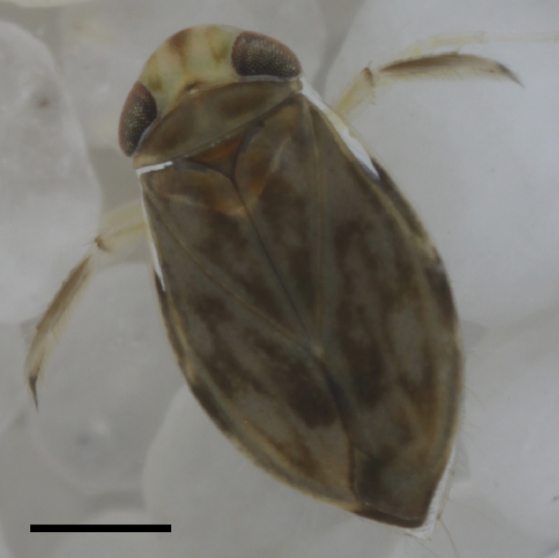 Micronecta ולץ הגבעות של האזור הכפרי באירופה חיות במקהלה של אהבה, לצרוח, באגים מימיים גבריים. החרק הקטן מעל, Micronecta ולץ (חותרניים), צעדים ב2.3mm עצום, ובכל זאת מייצר לחיצה / זמזם צליל בקלות נשמע לאדם אוזן מעל פני המים. כדי לשים את זה בפרספקטיבה נכונה: מנסה לשמוע מישהו מתחת למים שיחה בזמן שעמד לצד הבריכה הוא כמעט בלתי אפשרי, עדיין חרקים ברגע זה יוצר לחץ בקול רם מספיק כדי להיחשב בטעות לarthropod יבשתי. בעוד שזה לא נשמע מרשים מדי כאשר אנו מוקפים בחרקים חזקים אחרים כמו הצרצר, ז. scholtzi מתברר שהוא בעל חיים מדהים בקול רם כאשר אתה לוקח בחשבון את גודל הגוף ובינוני הקול ומתפשטים דרך להגיע האוזן שלנו. הכניס לתוך מספרי עוצמת הלחיצות מתחת למים יכול להגיע עד 100 dB (רמת לחץ קול, SPL). לכווץ אותנו לעולם החרקים והפקת צליל זה שווה ל פטיש אוויר באותו המרחק! אז מה לכל הרוחות אפשר באג הקטן הזה כדי להפוך את הרעש הזה ולצאת מזה בעולם מלא של טורפים?
המחברים באופן טבעי להצביע על כמה מפתיע תוצאות אלה. הדבר הראשון שמתברר הוא שספני המים חייבים להיות לא טורפי שמיעה שכן הם בעצם שוחים סביב מה שהופך את רוב הרעש אפשריים מבחינה פיזית עבור כל בעל חיים קטנים בכל מקום. באמת זה לא מפתיע יותר מדי שכן רוב הטורפים מתחת למים הם ציידים חזותיים בלבד (זחלי שפירית, באגים מים וחיפושיות וכו '…). סביר מאוד להניח שהברירה מינית הנחתה את הפיתוח של שיחות stridulatory אלה לרמות מדהימות כזה. הדבר המפתיע ביותר השני הוא ברור ברגע שאתה הגרף עד כמה רם חרקים אלה הם יחסית לגודל גופם. בחלק העליון של הגרף הוא דולפינן (ט. קטום) עם סונאר המפורסם שלה. אבל הנתון החריג הגדול ביותר הוא למעשה החרק הקטן שלנו בצד שמאל למטה עם היחס הגבוה ביותר בין הצליל וגודל גוף (31.5 עם ממוצע של 6.9). אין חיה ידועה אחרת מתקרבת. סביר להניח כי למרות בדיקה נוספת של חרקים מימיים אחרים שעשויה להניב דומה אם תוצאות לא מפתיעות יותר!
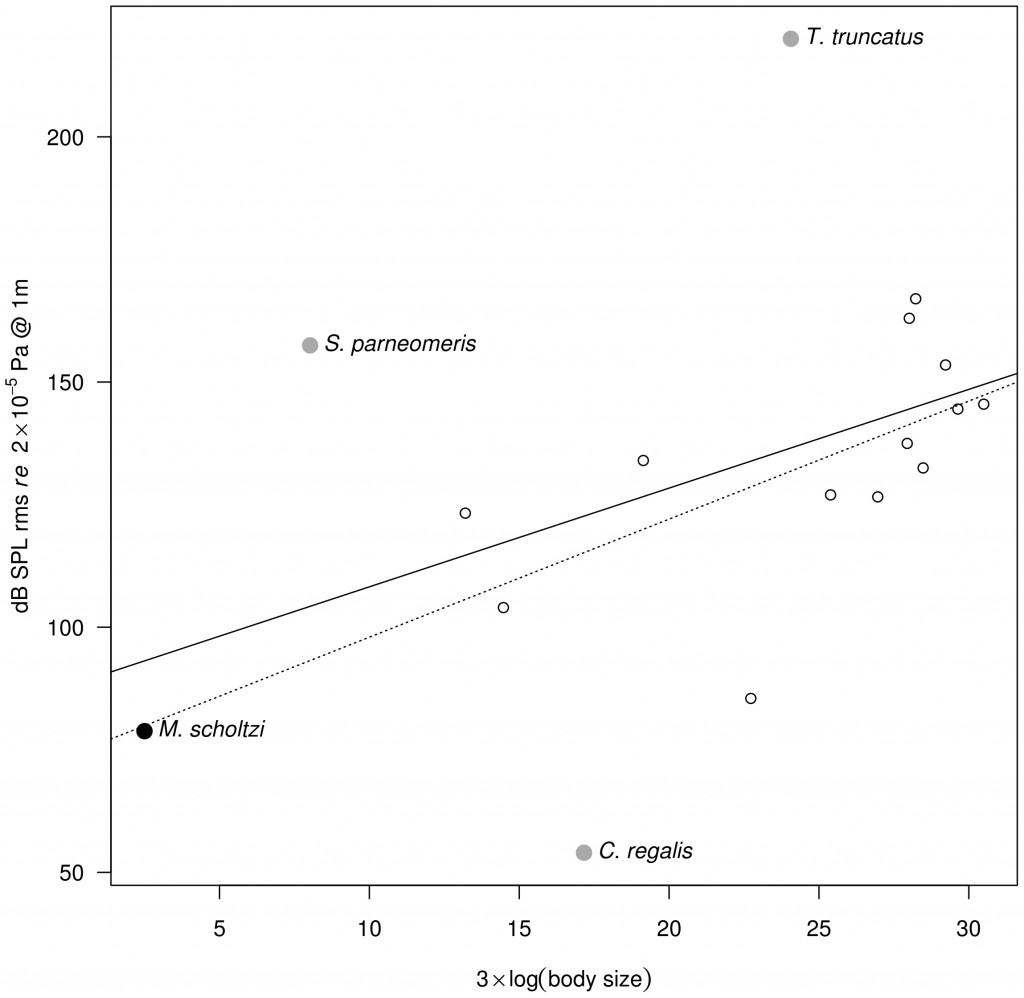
כדי להיות מדויק יותר על “לצרוח”, באגים (באגים במקרה זה הוא נכון; Corixidae שייך לסדר Hemiptera – באגים האמיתיים) צפוי להיות stridulating – שפשוף בין שני חלקים כדי ליצור צליל במקום אוויר נשיפה, תיפוף, וכו '… במאמר המחברים משערים כי “נשמע מופק על ידי שפשוף stridens סעיפים על paramere תקין (תוספת אברי מין) נגד רכס באונה השמאלית של קטע הבטן השמיני [15]”. מבלי למשוך את הציטוט שלהם, נראה stridulation שעל ידי גברים בסוג מתועד היטב למשיכת בן זוג. וכפי שהיית מצפה, ערוצי חדשות ועיתונאים מדע לקרוא “תוספת אברי מין” ולתרגם את זה לפין: ואתה בסופו של דבר עם סיפורים כמו זה. הפונקציה של parameres יכולה להיות מתורגמת באופן רופף לדומה ללסתות בכך שהם מבנים המתנגדים (בדרך כלל חמוש בשערות) לאחיזה. ה בהם שימוש מדויק עשוי להיות שונה על ידי מינים או אפילו הזמנות, אבל הם צורה מאוד ברורה את הפין (= Aedeagus) שכן הם פשוט לעזור להקל על הזדווגות ולא תישא בכל זרע. אז במציאות יש לך אברי המין “סוגרים” עם “stridens סעיפים”. וההמחשה הטובה ביותר של stridens סעיפים נגמרה על ארכיטיפ בלוג הישן. המבנה הזה מודגש להלן בצהוב (וקורה להתקיים על הבטן של הנמלה). אבל בקיצור – זה משטח רגיל מחורץ דומה לקרש כביסה. בסופו של המשפט שצוטט לעיל צריך להיות מתורגם ל “שני מבנים בקצה של הבטן שלשפשף יחדיו אוהבים שתי אצבעות מצלמים”.
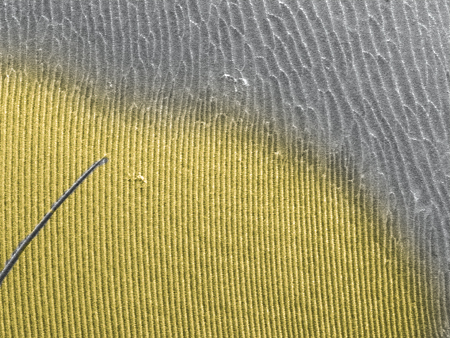 פירוט של סעיפים stridens (בצהוב) על tergite שוב הבטן בעובד villosa Pachycondyla (סריקת אלקטרונים מיקרוסקופ, רוברטו קלר / AMNH) Continue reading The incredibly loud world of bug sex
על ידי כריס Grinter, on June 20th, 2011 אני הולך להמשיך את הכדור עם הסדרה הזו ולנסות להפוך אותה לסדירה יותר. אני גם אתמקד בהדגשת מין חדש בכל שבוע מהאוספים העצומים כאן באקדמיה למדעים של קליפורניה. זה אמור לתת לי מספיק חומר בשביל… לפחות כמה מאות שנים.
 גרמיה אדוורדסי (ערבידי: Arctiinae) הדגימה של השבוע היא עש הנמר גרמיה אדוורדסי. עד לפני כמה שנים נחשבה משפחת עשים זו לנפרדת מה-Noctuidae – אבל ניתוח מולקולרי ומורפולוגי עדכני מראה שזהו למעשה נוקטואיד. משפחת ה-Erebidae נשלפה מתוך ה-Noctuidae וה- Arctiidae הונחו בה., הפיכתם לתת-משפחת Arctiinae. בסדר, טקסונומיה משעממת שלא תהיה – הכל מהכל, זה עש יפהפה וכמעט שום דבר לא ידוע עליו. דגימה זו נאספה בסן פרנסיסקו ב 1904 – למעשה כמעט כל הדגימות המוכרות ממין זה נאספו בעיר בסביבות תחילת המאה. אמנם עש זה נראה מאוד דומה לשופע והנפוץ גרמיה אורנטה, ניתוח מדוקדק של העיניים, צורת הכנף והאנטנות טוענות כי זהו למעשה מין נפרד. אני מאמין שהדגימה האחרונה נאספה בסביבות שנות ה-20 והיא לא נראתה מאז. סביר ומצער שעש זה נכחד במהלך האחרון 100 שנים של פיתוח של אזור מפרץ SF. גרמיה, ו-Arctiinae בכלל, אינם ידועים ברמות גבוהות של סגוליות מארח; הם נוטים להיות כמו פרות קטנות ולהאכיל כמעט מכל דבר בדרכם. אז זה עדיין תמוה מדוע לעש זה לא יהיה בית גידול היום, אפילו בעיר מופרעת כל כך. אולי העש הזה התמחה באזורי ביצות המלח המקיפים את המפרץ – שכולם נמחקו מאז עקב הטמנה לנדל"ן (1/3 של המפרץ כולו אבד למילוי). או אולי העש הזה נשאר איתנו גם היום אבל אף פעם לא נאסף כי הוא מין מעופף יום מתחמק. אני תמיד צופה בפארק באביב כדי לקבל טשטוש כתום קטן…
|
ספקנות
|














